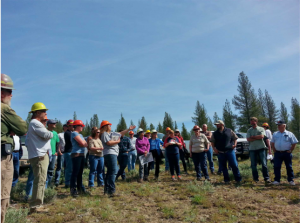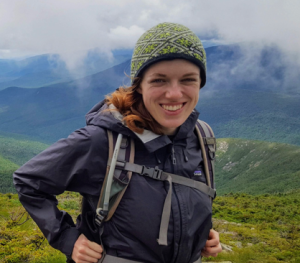
By Zoë McAlear for EDRBlog.org
For practitioners working on the ground, it can be reinvigorating, inspiring, and enormously helpful to learn from others’ experiences doing similar work. A recent webinar through the America’s Rural Opportunity Speaker Series titled, “Tension as Catalyst: Land Stewardship and Development Align for a Better Rural West,” provides people working on collaborative natural resource management and community development partnerships a chance to do just that. Learning about the partnership examples represented in this webinar gives practitioners the chance to compare the identified challenges with their own and examine what practices have been used most successfully, in order to push their personal work further or in new directions. Personally, as a student, learning from on-the-ground examples helps to move best practices out of the abstract and demonstrate how they make a tangible difference in people’s lives, which is a reminder of the day-to-day impact of collaborative processes.
The event, on June 10, 2019, was co-sponsored by the Rural Development Innovation Group, the Rural Voices for Conservation Coalition, the Aspen Institute Community Strategies Group, and Mark O. Hatfield School of Government at Portland State University, with support from the U.S. Forest Service. The panel conversation included five rural and tribal innovators sharing their thoughts on and personal experience with collaborative partnerships that focus on the pairing of natural resource management with community and economic development. Four of the five panelists represented specific collaboration efforts: William Barquin, Attorney General of the Kootenai Tribe of Idaho, representing the Kootenai Valley Resource Initiative (KVRI); Toni Ruth, Executive Director of Salmon Valley Stewardship; Mark Webb, Executive Director for Blue Mountains Forest Partners (BMFP) and Susan Jane Brown, Board Vice President for the BMFP and Staff Attorney with the Western Environmental Law Center. The fifth panelist included Mark Haggerty of Headwaters Economics. The panel was moderated by Tony Cheng, a professor in the Department of Forest and Rangeland Stewardship and Director of the Colorado Forest Restoration Institute at Colorado State University.
Get notified when new articles are posted to the EDR blog – sign up for our email list »
As the title of the webinar suggests, the panelists spoke from personal experience to identify the “catalyst” that led them to think creatively about how they were approaching local issues and forming long-term partnerships. They also shared valuable lessons that they have learned over the years. What most stood out to me is how well each of these stories exemplified key dispute resolution and collaboration best practices, demonstrating how they work in practice to make partnerships more effective. Let me illustrate through the case of the Blue Mountains Forest Partners (BMFP):
Susan Jane Brown’s successful litigation challenging federal timber sales in the early 2000s was the catalyst for the formation of the Blue Mountains Forest Partners. The County Commissioner for the area surrounding the Malheur National Forest in Eastern Oregon was concerned with how the litigation was “strangling” the community, and decided to approach Brown and invite her to visit Eastern Oregon to talk to those affected by the lack of timber sales. Following this initial visit, and through years of hard work, they created a better way forward through the BMFP, which is a “diverse group of stakeholders who work together to create and implement a shared vision to improve the resilience and well-being of forests and communities in the Blue Mountains” (BMFP website).
Although ripe with many learnings for practitioners, BMFP’s story drives home three fundamental dispute resolution and collaboration techniques:
1.) Understand your BATNA (Best Alternative to a Negotiated Agreement): As Mark Webb explained, he and others realized, after losing many court cases, that the “status quo was not an option” and that traditional methods of dispute resolution were not working for their community. Recognizing their lack of options, they risked reaching out to Brown, whose beliefs were vastly different from their own. They did this knowing that an attempt to pursue a new approach might alienate those in their personal and professional communities. In the end, though, their willingness to be vulnerable paid off by bringing in those on the other side to identify common interests and pursue mutually beneficial outcomes. (In a negotiation, your BATNA is the best possible outcome for you if no agreement is reached.)
2.) Focus on interests, instead of positions: From the outset, BMFP partners knew that they would need to find common ground in order to be successful. For them, this looked like a reframing of their discussions to focus on a new question: “What does the landscape need?” This change in perspective facilitated a focus on their different interests with regards to the landscape’s future, without letting them get bogged down in the details of their specific positions. This allowed them to find projects that all sides find mutually beneficial, as they identified a common interest in the future health and sustainability of the landscape, for the environment and for people. An example of this is the ten-year stewardship contract between Malheur National Forest officials and a local logging company, which is now responsible for the forest restoration work and supports local jobs by selling the logs resulting from thinning to the local lumber mill to help ensure it stays open.
3.) “Go slow to go fast”: Webb described the initial phase of the BMFP as “three difficult years of developing relations with people you don’t like initially and think you could never understand,” but eventually “coming to understand where they’re coming from” (webinar). Partners in the BMFP took the necessary time to build trust and find ways to have productive conversations before they began to pursue specific projects together. This included spending time on joint fact-finding, or developing a shared understanding of the issues, by using field visits and relying on both internal and external science to build a knowledge base for their decisions. They built a strong foundation before attempting to tackle complicated projects, which means that now – 17 years into their partnership – they are very active and able to make significant gains in their work together on a regular basis.
This collaborative, as well as the others featured in the webinar, are long-term, stable partnerships that have overcome many challenges in order to accomplish the work that they do today. As such, they are useful case studies for practitioners to learn from, providing positive reminders of the importance of this work and the possibility of great successes. More personally, they reinforce what I’m learning as a student by demonstrating that the dispute resolution and collaboration best practices I read and learn about in the classroom actually seem to work in the field.

Zoë McAlear is a current master’s student in the Department of Urban Studies and Planning at the Massachusetts Institute of Technology, with a concentration in Environmental Policy and Planning. She is spending the summer of 2019 as a fellow with the EDR Program. Zoë has a strong interest in how to better plan for and manage the nature and natural resources in and around our cities, particularly through inclusive, community-based processes and collaborative efforts. Her primary current research interests include collaborative natural resource management and urban climate change adaptation.
